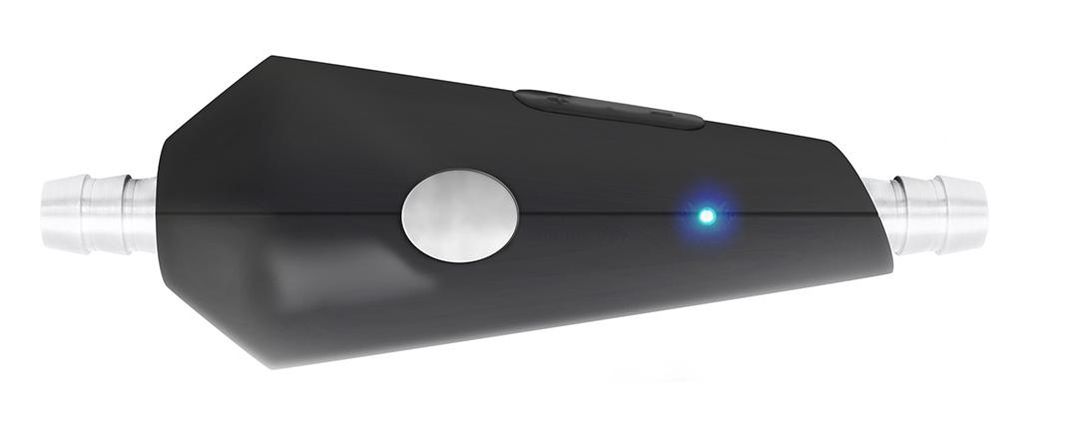This Smart Stethoscope Attachment Could Lead to More Accurate Diagnoses
Eko Core clips on to existing stethoscopes and lets physicians share heart sounds through their smartphones and the Web
/https://tf-cmsv2-smithsonianmag-media.s3.amazonaws.com/filer/ce/c1/cec1fb66-b32d-403d-bb1d-8e9b8e969756/eko_doctor_girl.jpg)
Sometimes, the best way to make new technology appealing is to integrate it into existing devices. That’s the idea behind the Eko Core, a tool that brings the modern stethoscope into the age of the smartphone and cloud computing.
The Core, developed by Berkeley, California-based startup Eko Devices, pairs with a smartphone or tablet over Bluetooth, and records heart sounds. The audio can instantly be shared with a cardiologist anywhere for an expert opinion, or compared to heart sounds in a cloud-based database, to help discern the likelihood of a heart murmur or other serious issue.
Rather than replacing the traditional stethoscope, which many physicians see as an emblem of their profession, the Eko Core attaches to it, between the ear and chest pieces, allowing the analogue features of the stethoscope to remain intact.

According to Jason Bellet, co-founder and COO of the company, the initial idea came out of a class on healthcare innovations that he and his business partners took at UC Berkeley in 2012.
“During a visit to a Bay Area hospital, it became very apparent that the stethoscope, the physician’s lead tool for cardiac monitoring, is a 200-year-old outdated technology,” says Bellet. “An icon of medicine is really at fault for a tremendous amount of healthcare waste and overscreening.”
One might think, given the prevalence of the stethoscope, that every general practitioner and ER resident has an expert ear for heart sounds. But correctly reading these sounds is a tricky skill that can take years to develop, especially if a doctor isn’t a cardiologist. This reality leads to expensive and often unnecessary tests and in-person consultations with specialists.
While hard statistics for the cost of unnecessary cardiologists are hard to come by, an eConsult program at UC San Francisco that lets primary care physicians communicate with specialists virtually has reportedly cut wait times by 52 percent, while reducing the number of new patient visits to specialists, and reducing referral costs from $232 and up for one in-person consultation to just $57 for an eConsult.
The Eko Core aims to make virtual consultation even simpler and, in doing so, cut costs dramatically, while more efficiently and accurately diagnosing serious heart issues. With it, a physician can send heart sounds directly to a cardiologist anywhere in the world, as long as the consulting doctor also has a stethoscope fitted with an Eko Core. If not, the specialist on the receiving end can listen to the sounds on his or her computer, smartphone or tablet using headphones.
A few stethoscopes already on the market have the ability to record. 3M’s Littmann 3200, for instance, can record and store up to 12 heart readings. But it pairs with a proprietary USB dongle, so is meant to be used with a desktop or laptop computer, not mobile devices, and Apple products are not supported. Bellet says this model doesn't jibe with the transient nature of clinical medicine, which involves physicians constantly traveling from room to room.
“Efficiency is the biggest thing in modern healthcare,” says Bellet. “A connected device needs to be connected to the tools that physicians rely on.” Eko Devices has developed software that streams stethoscope sounds to Apple or Android phones and tablets, then uploads them to the cloud where they can be listened to, securely, from virtually any Web-connected device.
With recorded heart sounds that can be played back from a cloud-based database, the device could be used for teaching as well. Similar web-based tools for doctors already exist, such as Johns Hopkins University’s Murmurlab, a Web database of recorded heart sounds designed to teach physicians how to make better diagnoses by listening to thousands of examples. But while Murmurlab is designed to be used with a computer, the Eko Core would let medical students and physicians listen to heart sounds virtually anywhere.
The company will sell the Core for approximately $200, which is about a third the cost of current digital stethoscopes. It also features active noise cancelling and amplification, which will no-doubt benefit doctors trying to get heart readings in crowded emergency rooms or in other noisy situations.
Don’t expect to see the Eko Core around the neck of your primary care physician at your next checkup though, unless your doctor’s office is located in the San Francisco Bay Area. Pilot programs using the Eko Core could begin at hospitals there as early as February, according to Bellet. While the company says the institutional review board process is underway, the device still has to be approved by the FDA before interested physicians across the country can add the Core to their own stethoscopes.
“We’re really focused on commercializing [the Eko Core], and the impact it can have on cardiac monitoring—particularly long-term patient management,” says Bellet. “That said, we’re always looking at other uses for this particular technology.”
/https://tf-cmsv2-smithsonianmag-media.s3.amazonaws.com/accounts/headshot/unnamed.jpg)
/https://tf-cmsv2-smithsonianmag-media.s3.amazonaws.com/accounts/headshot/unnamed.jpg)